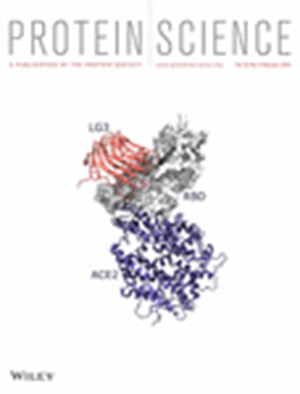用于多肽毒性预测的结构感知深度学习模型
IF 4.5
3区 生物学
Q1 BIOCHEMISTRY & MOLECULAR BIOLOGY
引用次数: 0
摘要
抗菌药耐药性是一个重要的公共卫生问题,因此有必要探索替代治疗方法。虽然抗菌肽(AMPs)前景广阔,但使用传统的湿实验室方法评估其毒性既耗时又昂贵。我们介绍的 tAMPer 是一种新型多模态深度学习模型,旨在通过整合肽的底层氨基酸序列组成和三维结构来预测肽的毒性。tAMPer 采用基于图的肽表示法,编码 ColabFold 预测的结构,其中节点代表氨基酸,边代表空间相互作用。使用图神经网络提取结构特征,并通过递归神经网络捕捉序列依赖关系。tAMPer 的性能在公开的蛋白质毒性基准和我们生成的 AMP 溶血数据上进行了评估。在后者上,tAMPer 的 F1 分数达到 68.7%,比第二好的方法高出 23.4%。在蛋白质基准上,与当前最先进的方法相比,tAMPer 的 F1 分数提高了 3.0%。我们预计,tAMPer 可以减少对费力的毒性筛选实验的依赖,从而加速 AMP 的发现和开发。本文章由计算机程序翻译,如有差异,请以英文原文为准。
Structure‐aware deep learning model for peptide toxicity prediction
Antimicrobial resistance is a critical public health concern, necessitating the exploration of alternative treatments. While antimicrobial peptides (AMPs) show promise, assessing their toxicity using traditional wet lab methods is both time‐consuming and costly. We introduce tAMPer, a novel multi‐modal deep learning model designed to predict peptide toxicity by integrating the underlying amino acid sequence composition and the three‐dimensional structure of peptides. tAMPer adopts a graph‐based representation for peptides, encoding ColabFold‐predicted structures, where nodes represent amino acids and edges represent spatial interactions. Structural features are extracted using graph neural networks, and recurrent neural networks capture sequential dependencies. tAMPer's performance was assessed on a publicly available protein toxicity benchmark and an AMP hemolysis data we generated. On the latter, tAMPer achieves an F1‐score of 68.7%, outperforming the second‐best method by 23.4%. On the protein benchmark, tAMPer exhibited an improvement of over 3.0% in the F1‐score compared to current state‐of‐the‐art methods. We anticipate tAMPer to accelerate AMP discovery and development by reducing the reliance on laborious toxicity screening experiments.
求助全文
通过发布文献求助,成功后即可免费获取论文全文。
去求助
来源期刊

Protein Science
生物-生化与分子生物学
CiteScore
12.40
自引率
1.20%
发文量
246
审稿时长
1 months
期刊介绍:
Protein Science, the flagship journal of The Protein Society, is a publication that focuses on advancing fundamental knowledge in the field of protein molecules. The journal welcomes original reports and review articles that contribute to our understanding of protein function, structure, folding, design, and evolution.
Additionally, Protein Science encourages papers that explore the applications of protein science in various areas such as therapeutics, protein-based biomaterials, bionanotechnology, synthetic biology, and bioelectronics.
The journal accepts manuscript submissions in any suitable format for review, with the requirement of converting the manuscript to journal-style format only upon acceptance for publication.
Protein Science is indexed and abstracted in numerous databases, including the Agricultural & Environmental Science Database (ProQuest), Biological Science Database (ProQuest), CAS: Chemical Abstracts Service (ACS), Embase (Elsevier), Health & Medical Collection (ProQuest), Health Research Premium Collection (ProQuest), Materials Science & Engineering Database (ProQuest), MEDLINE/PubMed (NLM), Natural Science Collection (ProQuest), and SciTech Premium Collection (ProQuest).
 求助内容:
求助内容: 应助结果提醒方式:
应助结果提醒方式:


